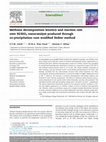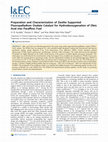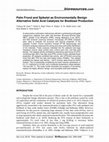Papers by Wan Mohd Ashri Wan Daud

International Journal of Hydrogen Energy, 2017
Co-precipitation cum modified St€ ober method was adopted to produce nano-Ni/SiO 2 (n-Ni/ SiO 2) ... more Co-precipitation cum modified St€ ober method was adopted to produce nano-Ni/SiO 2 (n-Ni/ SiO 2) catalyst and conducted a series of methane decomposition kinetic experiments in a fixed bed pilot plant. Methane decomposition activity of n-Ni/SiO 2 catalyst was quantified by considering thermodynamic deposition of carbon at a temperature range of 550e650 C and methane partial pressure from 0.2 to 0.8 atm. The utmost methane conversion of 18.87 mmol/g cat min was obtained at 650 C and methane partial pressure of 0.8 atm. The findings concluded that the enhancement occurred with carbon formation rate when increasing the methane partial pressure is very much evident at higher temperature such as 650 C. However, the intensity in methane decomposition descending tendency was declined at lower reaction temperature. The effects of methane partial pressure and reaction temperature on the specific molar carbon formation rate were also examined. The calculated reaction order and activation energy were 1.40 and 61.1 kJ mol À1 , respectively. The kinetic experiments showed the existence of an optimum reaction condition to achieve the highest performance of n-Ni/SiO 2 catalyst in terms of methane decomposition rate. However, carbon accumulation ceases once complete catalyst deactivation occurred at certain reaction conditions such as high temperature and lower methane partial pressure. Virgin nanocatalyst and as-produced nanocarbons were studied with BET, XRD, and TEM.

The application of superparamagnetic nanoparticles as heating agents in hyperthermia therapy has ... more The application of superparamagnetic nanoparticles as heating agents in hyperthermia therapy has made a therapeutic breakthrough in cancer treatment. The high efficiency of this magnetic hyperthermia therapy has derived from a great capability of superparamagnetic nanoparticles to generate focused heat in inaccessible tumors being effectively inactivated. The main challenges of this therapy are the improvement of the induction heating power of superparamagnetic nanoparticles and the control of the hyperthermia temperature in a secure range of 42 °C to 47 °C, at targeted area. The variation of these hyperthermia properties is principally dependent on the magnetic nanoparticles as well as the magnetic field leading to enhance the efficiency of magnetic hyperthermia therapy at targeted area and also avoid undue heating to healthy cells. The present study evaluates the magnetic hyperthermia therapy through the determination of superparamagnetic nanoparticles properties and magnetic field' parameters.

Enzymatic hydroesterification has recently attracted research interest because of the high-value ... more Enzymatic hydroesterification has recently attracted research interest because of the high-value products created during biodiesel production. The use of this process overcomes problems related to conventional methods for biodiesel production, such as slow reaction rate and soap formation. The method comprises two basic processes to produce fatty acid alkyl esters from triacylglycerols, namely, enzymatic hydrolysis and enzymatic esterification. Although enzymatic hydroesterification for biodiesel production has many advantages, such as lower energy consumption and converting low-quality feedstock, it has not been used on an industrial scale mainly because of some impediments, including enzyme cost and conversion efficiency. This review presents a comprehensive evaluation of recent investigations on enzymatic hydrolysis and enzymatic esterification to lower process costs and increase yields.

Oleic acid (OA) was hydrodeoxygenated in this study using zeolite-supported fluoropalladium oxala... more Oleic acid (OA) was hydrodeoxygenated in this study using zeolite-supported fluoropalladium oxalate (FPdOx/ Zeol) catalyst. The FPdOx/Zeol was prepared via a pH controlled simple dissolution method and characterized with thermal gravimetric analysis, energy dispersive X-ray, X-ray fluorescence, X-ray diffraction (XRD), Fourier transform infrared spectroscopy (FTIR), Raman spectroscopy, and Brunauer−Emmett−Teller techniques. The results showed that the deposited Pd particle was highly dispersed on the zeolite (Zeol) because of the presence of oxalate ligands and proper calcination. This observation was corroborated by the transformation of the Zeol support from crystalline into amorphous in FPdOx/Zeol as seen in the XRD and scanning electron microscopy results. The best experimental condition for the hydrodeoxygenation (HDO) of 3.5 g of OA was 370°C, 20 mg of FPdOx/Zeol, and 100 mL/min of reducing gas (5% H 2 /N 2 ) flow rate. The FTIR spectra of the evolved products at these conditions showed that the HDO of OA proceeded via the formation of stearic acid as intermediate product. A mixture of highly purified paraffinic fuel (iso-octadecane, ∼18%, and n-ocatadecane, ∼69%) was obtained after 44 min of HDO. The production of iso-octadecane which is an excellent fuel additive because of its antifreezing quality was due to the presence of fluoride ion in the FPdOx/Zeol. The FPdOx/Zeol demonstrated excellent qualities, and the results are promising toward further research and industrialization.

Thermocatalytic decomposition of methane (TCD) is a fully green single step technology for produc... more Thermocatalytic decomposition of methane (TCD) is a fully green single step technology for producing hydrogen and nano-carbon. This review studying all development in laboratory-scale research on TCD, especially the recent advances like co-feeding effect and catalyst regeneration for augmenting the productivity of the whole process. Although a great success on the laboratory-scale has been fulfilled, TCD for greenhouse gas (GHG) free hydrogen production is still in its infancy. The need for commercialization of TCD is greater than ever in the present situation of huge GHG emission. TCD usually examined over various kind of catalysts, such as monometallic, bimetallic, trimetallic, combination of metal–metal oxide, carbonaceous and/or metal doped carbon catalysts. Deactivation of catalysts is the prime drawback found in TCD process. Catalyst regeneration and co-feeding of methane with other hydrocarbon are the two solutions put forwarded in accordance to overcome deactivation hurdle. Higher amount of co-feed hydrocarbon in situ produce more amount of highly active carbonaceous deposits which assist further methane decomposition to produce additional hydrogen to a great extent. The methane conversion rate increases with increase in the temperature and decreases with the flow rate in the co-feeding process in a similar manner as observed in normal TCD. The presence of co-components in the post-reaction stream is a key challenge tackled in the co-feeding and regeneration. Hence, this review hypothesizing the integration of hydrogen separation membrane in to methane decomposition reactor for online hydrogen separation.

A carbonization-sulfonation method was utilized in synthesizing sulfonated mesoporous catalysts f... more A carbonization-sulfonation method was utilized in synthesizing sulfonated mesoporous catalysts from palm tree biomass. Brunauer-Emmet-Teller (BET), powder X-ray diffraction (XRD), energy dispersive X-ray (EDX), and field emission scanning emission microscopy (FE-SEM) analyses were used to evaluate the structural and textural properties of the catalysts. Further, Fourier transform infrared (FT-IR) spectroscopy and titrimetric analyses measured the strong acid value and acidity distribution of the materials. These analyses indicated that the catalysts had large mesopore volume, large surface area, uniform pore size, and high acid density. The catalytic activity exhibited by esterifying used frying oil (UFO) containing high (48%) free fatty acid (FFA) content further indicated these properties. All catalysts exhibited high activity, with sPTS/400 converting more than 98% FFA into fatty acid methyl esters (FAMEs). The catalyst exhibited the highest acid density, 1.2974 mmol/g, determined by NaOH titration. This is outstanding considering the lower reaction parameters of 5 h, 5:1 methanol-to-oil ratio, and a moderate temperature range between 100 and 200 °C. The study further illustrates the prospect of converting wastes into highly efficient, benign, and recyclable solid acid catalysts.

Biomass & Bioenergy, May 1, 2011
Agriculture residues such as palm shell are one of the biomass categories that can be utilized fo... more Agriculture residues such as palm shell are one of the biomass categories that can be utilized for conversion to bio-oil by using pyrolysis process. Palm shells were pyrolyzed in a fluidized-bed reactor at 400, 500, 600, 700 and 800 °C with N 2 as carrier gas at flow rate 1, 2, 3, 4 and 5 L/min. The objective of the present work is to determine the effects of temperature, flow rate of N 2, particle size and reaction time on the optimization of production of renewable bio-oil from palm shell. According to this study the maximum yield of bio-oil (47.3 wt%) can be obtained, working at the medium level for the operation temperature (500 °C) and 2 L/min of N 2 flow rate at 60 min reaction time. Temperature is the most important factor, having a significant positive effect on yield product of bio-oil. The oil was characterized by Fourier Transform infra-red (FT-IR) spectroscopy and gas chromatography/mass spectrometry (GC-MS) techniques. © 2011 Elsevier Ltd.
http://ac.els-cdn.com/S0961953411000341/1-s2.0-S0961953411000341-main.pdf?_tid=c01d529e-2364-11e4-b14e-00000aab0f01&acdnat=1407987815_38df3136aff621641d9b7c7847e37254
http://www.sciencedirect.com/science/article/pii/S0961953411000341

Energy Conversion and Management, Dec 1, 2013
Oil palm tree residues are a rich biomass resource in Malaysia, and it is therefore very importan... more Oil palm tree residues are a rich biomass resource in Malaysia, and it is therefore very important that they be utilized for more beneficial purposes, particularly in the context of the development of biofuels. This paper described the possibility of utilizing oil palm tree residues as biofuels by producing bio-oil and bio-char via pyrolysis. The process was performed in a fixed-bed reactor at a temperature of 500 C, a nitrogen flow rate of 2 L/min and a reaction time of 60 min. The physical and chemical properties of the products, which are important for biofuel testing, were then characterized. The results showed that the yields of the bio-oil and bio-char obtained from different residues varied within the ranges of 16.58-43.50 wt% and 28.63-36.75 wt%, respectively. The variations in the yields resulted from differences in the relative amounts of cellulose, hemicellulose, lignin, volatiles, fixed carbon, and ash in the samples. The energy density of the bio-char was found to be higher than that of the bio-oil. The highest energy density of the bio-char was obtained from a palm leaf sample (23.32 MJ/kg), while that of the bio-oil was obtained from a frond sample (15.41 MJ/kg). © 2013 Elsevier Ltd. All rights reserved.
http://ac.els-cdn.com/S0196890413005128/1-s2.0-S0196890413005128-main.pdf?_tid=b920af18-2364-11e4-9454-00000aab0f02&acdnat=1407987803_f10a9bd8d218d3e72eef3c3e35b787b4
http://www.sciencedirect.com/science/article/pii/S0196890413005128
Journal of Analytical and Applied Pyrolysis, 2010

Environmental Technology (United Kingdom), 2012
The mineralisation of remazol black B (RBB) was studied at concentrations ranging from 20-1000 mg... more The mineralisation of remazol black B (RBB) was studied at concentrations ranging from 20-1000 mgL-1. The work was aimed at investigating the Fenton-like peroxidation of RBB at a concentration typically obtained in Batik cottage industries. Other response parameters were degradation and colour removal efficiencies. The parameters that were measured included total organic carbon (TOC), chemical oxygen demand (COD) as well as absorbance for mineralisation, degradation and colour. To optimise the process, the interaction effects of several controlling variables on the treatment process were examined using dispersion matrix-optimal design and response surface analysis. Four specific variables: initial dye concentration (Dye)o; the molar ratio of oxidant to dye organic strength (H2O2):(COD); the mass ratio of the oxidant to the catalyst (H2O2):(Fe 3+) and reaction time (tr), were observed. Three reduced empirical models, one for each response, were developed for describing the treatment process. For 20, 510 and 1000 mgL-1, the optimum %TOC reduction and oxidation times were 44% for 95 min, 52% for 52.5 min and 68% for 10 min corresponding to 67, 81 and 75% COD reduction, respectively. The optimum COD reduction and oxidation times were 89% for 95 min, 91% for 10 min and 84% for 95 min for concentrations of 20, 510 and 1000 mg L-1, respectively. For all concentrations, total colour removal was achieved. A comparison of the results obtained in this study with literature values for traditional Fenton, photo-Fenton and photo-Fenton-like oxidation indicated that the TOC reduction obtained using the Fenton-like process was satisfactory. © 2012 Taylor & Francis.
http://www.tandfonline.com/doi/pdf/10.1080/09593330.2011.610360

Chemical Engineering Journal, Dec 15, 2011
The cocoa shell (CS) flake was ground, sieved and pressed into pellets. The pellets were carboniz... more The cocoa shell (CS) flake was ground, sieved and pressed into pellets. The pellets were carbonized at 800 ° C and subjected to activation at 850 ° C under a flow of CO 2 for several activation burn off. The cocoa shell-based activated carbon (CSAC) showed moderate surface area (248 m 2 g -1), a low mesoporosity ratio with a pore size in the range between 2 and 4 nm. CSAC also displays the presence of aliphatic, aromatic hydrocarbons, C O and a near absence of C-O. CSAC was evaluated for its ability to adsorb 4-nitrophenol (4-NP). The adsorption time and initial dye concentration study on adsorption performance was carried out in a batch system. The results indicate that the Freundlich, Temkin and Langmuir isotherms fit well (R 2 > 0.9). The results from the kinetic study show that 4-NP adsorption follows pseudo-second-order and Boyd models. © 2011 Elsevier B.V.
http://ac.els-cdn.com/S1385894711012836/1-s2.0-S1385894711012836-main.pdf?_tid=b05409fc-2364-11e4-85bf-00000aab0f26&acdnat=1407987789_24e3f74bc91242775cf421abae2ca1b9
http://www.sciencedirect.com/science/article/pii/S1385894711012836

Process Safety and Environmental Protection, Mar 1, 2011
This paper presents a brief account of different technologies used for the treatment of petroleum... more This paper presents a brief account of different technologies used for the treatment of petroleum refinery effluents (PRE). Broadly, PRE treatment is accomplished in two stages, namely, a series of pre-treatment steps, in which suspended matter, oil and grease are reduced, and an advanced stage, in which wastewater contaminants are decreased to certain acceptable discharge limits. Photocatalytic degradation techniques have been widely used in water and wastewater treatment. However, the literature regarding PRE treatment is scarce, and the technique is still not being utilised on an industrial scale in refineries. This is largely due to limited research findings discussing PRE treatments. Most researches are focused on treating singular contaminants found in PRE, e.g., phenols, sulphides, oil, grease and other organic components. This review focused on works that investigated PRE treatment by monitoring general refinery wastewater parameters, namely, chemical oxygen demand (COD), biological oxygen demand (BOD), total petroleum hydrocarbon (TPH), oil and grease (O&G), sulphate and phenols at the advanced treatment steps. This paper presents an overview of photocatalytic degradation and discusses published works with the goal of presenting the technique as an attractive and viable process unit. If optimised, this process has great potential for replacing other separation and degradation treatment approaches employed at the advanced treatment stage for PRE. © 2010 The Institution of Chemical Engineers.
http://ac.els-cdn.com/S0957582010001126/1-s2.0-S0957582010001126-main.pdf?_tid=ad24d2f2-2364-11e4-85bf-00000aab0f26&acdnat=1407987783_2679889d31a1d298d65dd23cc88a1a94
http://www.sciencedirect.com/science/article/pii/S0957582010001126

Fuel Processing Technology, Sep 1, 2009
Catalytic characteristics of activated carbon manufactured from palm shell (ACPS) for methane dec... more Catalytic characteristics of activated carbon manufactured from palm shell (ACPS) for methane decomposition was studied using a thermobalance by measuring thee mass gain with time. A reaction order of 0.5 is obtained for methane decomposition over the activated carbon and the activation energy is 210 KJ mol- 1. The activity of the activated carbon had decreased in almost a linear relationship with the amount of carbon deposited at 800 °C, which indicates that the carbon deposition occurred uniformly on to the carbon surface, while diffusion effect appeared to occur significantly at the last stage of the process at reaction temperatures up to 950 °C. The study of mass gain using different particle sizes indicates the existence of mass transfer effect and the pore mouth blocking which seem to take place particularly in large particles. Comparison between ACPS and commercial based activated carbon (AC) shows almost similar values with regard to change of mass gain with time, maximum amount of carbon deposited before deactivation and the deactivation time. © 2009.
http://ac.els-cdn.com/S0378382009001349/1-s2.0-S0378382009001349-main.pdf?_tid=a973af5c-2364-11e4-ab36-00000aab0f26&acdnat=1407987777_8b4f24ca9d35e3858558b480fec18774
http://www.sciencedirect.com/science/article/pii/S0378382009001349

International Journal of Hydrogen Energy, Oct 1, 2009
A series of experiments was conducted to study the deactivation and regeneration of activated car... more A series of experiments was conducted to study the deactivation and regeneration of activated carbon catalyst used for methane thermocatalytic decomposition to produce hydrogen. The catalyst becomes deactivated due to carbon deposition and six decomposition cycles of methane at temperatures of 850 and 950 °C, and five cycles of regeneration by using CO2 at temperatures of 900, 950 and 1000 °C were carried out to evaluate the stability of the catalyst. The experiment was conducted by using a thermobalance by monitoring the mass gain during decomposition or the mass lost during the regeneration with time. The initial activity and the ultimate mass gain of the catalyst decreased after each regeneration cycle at both reaction temperatures of 850 and 950 °C, but the amount is smaller under the more severe regenerating conditions. For the reaction at 950 °C, comparison between the first and sixth reaction cycles shows that the initial activity decreased by 69, 51 and 42%, while the ultimate mass gain decreased by 62%, 36% and 16% when CO2 gasification carried out at 900, 950 and 1000 °C respectively. Temperature -programmed oxidation profiles for the deactivated catalyst at reaction temperature of 950 °C and after several cycles showed two peaks which are attributed to different carbon characteristics, while one peak was obtained when the experiment was carried out at 850 °C. In conclusion, conducting methane decomposition at 950 °C and regeneration at 1000 °C showed the lowest decrease in the mass gain with reaction cycles. © 2009 Professor T. Nejat Veziroglu.
http://ac.els-cdn.com/S0360319909012634/1-s2.0-S0360319909012634-main.pdf?_tid=a537b208-2364-11e4-a1c7-00000aab0f6b&acdnat=1407987770_8819176b25424b9618d9df24bd946fac
http://www.sciencedirect.com/science/article/pii/S0360319909012634

Journal of Natural Gas Chemistry, May 1, 2010
Numerous researches were reviewed and interpreted to depict a comprehensive illustration of activ... more Numerous researches were reviewed and interpreted to depict a comprehensive illustration of activated carbon and its behavior towards oxidation. Activated carbon as one of the most important adsorbents is tried to be described in this review paper by terms of its "Textural Characteristics" and "Surface Chemistry". These two terms, coupled with each other, are responsible for behavior of activated carbon in adsorption processes and in catalytic applications. Although as-prepared activated carbons are usually nonselective and their surfaces suffer from lack of enough reactive groups, their different aspects may be improved and developed by diverse types of modifications. Oxidation is one of the most conventional modifications used for activated carbons. It may be used as a final modification or as a pre-modification followed by further treatment. In this paper, methods of oxidation of activated carbon and other graphene-layer carbon materials are introduced and wet oxidation as an extensively-used category of oxidation is discussed in more detail. Copyright © 2010, Dalian Institute of Chemical Physics, Chinese Academy of Sciences.
http://ac.els-cdn.com/S1003995309600669/1-s2.0-S1003995309600669-main.pdf?_tid=a195ee26-2364-11e4-98d9-00000aacb361&acdnat=1407987764_eafeb842a45f35f68a4a3d8b857bff2e
Chemical Engineering Journal, May 15, 2011

Energy & Fuels, 2014
This review evaluates a diverse portfolio of technologies that produce hydrogen from renewable en... more This review evaluates a diverse portfolio of technologies that produce hydrogen from renewable energy sources. A number of literature surveys and efficient hydrogen formation pathways are compared. The continuous improvement in hydrogen production pathways is of crucial importance in the making of hydrogen from sustainable energy sources. Evaluation of the economics in producing hydrogen from natural gas (NG), coal, biomass, atoms, sunlight and wind shows that the key to commercialization of hydrogen energy depends on feedstock cost, raw material availability, capital costs of equipment and how long the technology has been established. Estimates reveal that the hydrogen production cost (HPC) from coal is expected to be 0.36 to 1.83 US/kg, whereas for NG it is 2.48 to 3.17 US/kg. Depending on the type and cost of raw material employed, the HPC from biomass is expected to be in range of 1.44 to 2.83 US/kg, while the HPC from wind is expected to be 5.50 US/kg depending on the size of wind turbines and type of electrolyzers used. Compared to the HPC from coal and NG, the HPC from solar energy is much more higher (by more than 3 orders of magnitude). Considering the capital cost, energy consumption and operating costs, a HPC of 8 US/kg would be expected for the electrolysis of water. Nevertheless, if the cost of electricity is low, then it would be possible to produce hydrogen from solar and water electrolysis at a cheaper rate. This result implies that hydrogen production from coal, biomass and NG resources will be great enough to meet hydrogen demands in the near future. Of all of the current technologies employed for the yield of hydrogen from fuels, steam methane reforming (SMR) seems to be the most practical and established technology. By the SMR pathway, HPC from NG is expected to be 3.50 US/kg and 1.25 US/kg for small and large plant sizes, respectively, while the HPC from NG is estimated to have a cost of 6 US/GJ. However, production technologies including thermochemical pathways such as biomass gasification, pyrolysis, and supercritical water gasification (SCWG) and biological pathways such as photosynthesis, fermentation, and biological water gas shift reactions (BWGS) are also discussed. © 2014 American Chemical Society.
http://pubs.acs.org/doi/pdfplus/10.1021/ef5007808

Bulletin of the Chemical Society of Japan, Nov 15, 2011
Tailoring the surface chemistry of adsorbents, especially activated carbons, make them suitable t... more Tailoring the surface chemistry of adsorbents, especially activated carbons, make them suitable to specific applications. Many times oxidation is the first step and greatly affects the next steps of tailoring. We modified the surface chemistry of a microporous activated carbon (AC) by nitric acid solutions at different conditions of acid concentration, time, and oxidation temperature. The oxidized AC samples were inspected with the aid of physical adsorptiondesorption of nitrogen at 77 °C and temperature-programmed desorption (TPD). It was shown that oxidation by nitric acid lowers surface area of the studied AC even at mild severity. Moreover, different instrumental analysis pointed out creation of a considerable amount of oxygen-containing functional groups, especially acidic ones on the surface. Central composite design (CCD) was applied to evaluate the individual and interactive effects of oxidation parameters and to provide a compromise between the amount of oxygen groups and BET surface area as two of studied responses. The significant factors and interactions on each response were recognized by Analysis of Variance (ANOVA). A linear model and a two factor interaction (2FI) model were developed to correlate the oxidation conditions to BET surface area and the amount of oxygen surface groups. In addition, optimized oxidation conditions were established. © 2011 The Chemical Society of Japan.
https://www.jstage.jst.go.jp/article/bcsj/84/11/84_20110145/_article

Uploads
Papers by Wan Mohd Ashri Wan Daud
http://ac.els-cdn.com/S0961953411000341/1-s2.0-S0961953411000341-main.pdf?_tid=c01d529e-2364-11e4-b14e-00000aab0f01&acdnat=1407987815_38df3136aff621641d9b7c7847e37254
http://www.sciencedirect.com/science/article/pii/S0961953411000341
http://ac.els-cdn.com/S0196890413005128/1-s2.0-S0196890413005128-main.pdf?_tid=b920af18-2364-11e4-9454-00000aab0f02&acdnat=1407987803_f10a9bd8d218d3e72eef3c3e35b787b4
http://www.sciencedirect.com/science/article/pii/S0196890413005128
http://ac.els-cdn.com/S0165237010001178/1-s2.0-S0165237010001178-main.pdf?_tid=b63eb344-2364-11e4-aa91-00000aacb35d&acdnat=1407987798_4ec08a5d74cfdb3851cdf69f84a92b32
http://www.sciencedirect.com/science/article/pii/S0165237010001178
http://www.tandfonline.com/doi/pdf/10.1080/09593330.2011.610360
http://ac.els-cdn.com/S1385894711012836/1-s2.0-S1385894711012836-main.pdf?_tid=b05409fc-2364-11e4-85bf-00000aab0f26&acdnat=1407987789_24e3f74bc91242775cf421abae2ca1b9
http://www.sciencedirect.com/science/article/pii/S1385894711012836
http://ac.els-cdn.com/S0957582010001126/1-s2.0-S0957582010001126-main.pdf?_tid=ad24d2f2-2364-11e4-85bf-00000aab0f26&acdnat=1407987783_2679889d31a1d298d65dd23cc88a1a94
http://www.sciencedirect.com/science/article/pii/S0957582010001126
http://ac.els-cdn.com/S0378382009001349/1-s2.0-S0378382009001349-main.pdf?_tid=a973af5c-2364-11e4-ab36-00000aab0f26&acdnat=1407987777_8b4f24ca9d35e3858558b480fec18774
http://www.sciencedirect.com/science/article/pii/S0378382009001349
http://ac.els-cdn.com/S0360319909012634/1-s2.0-S0360319909012634-main.pdf?_tid=a537b208-2364-11e4-a1c7-00000aab0f6b&acdnat=1407987770_8819176b25424b9618d9df24bd946fac
http://www.sciencedirect.com/science/article/pii/S0360319909012634
http://ac.els-cdn.com/S1003995309600669/1-s2.0-S1003995309600669-main.pdf?_tid=a195ee26-2364-11e4-98d9-00000aacb361&acdnat=1407987764_eafeb842a45f35f68a4a3d8b857bff2e
http://ac.els-cdn.com/S1385894711003706/1-s2.0-S1385894711003706-main.pdf?_tid=9d4577e2-2364-11e4-a301-00000aacb362&acdnat=1407987757_a8e4cdcdb0529f1cbcf2d1d2aecff8d0
http://www.sciencedirect.com/science/article/pii/S1385894711003706
http://pubs.acs.org/doi/pdfplus/10.1021/ef5007808
https://www.jstage.jst.go.jp/article/bcsj/84/11/84_20110145/_article
http://ac.els-cdn.com/S0961953411000341/1-s2.0-S0961953411000341-main.pdf?_tid=c01d529e-2364-11e4-b14e-00000aab0f01&acdnat=1407987815_38df3136aff621641d9b7c7847e37254
http://www.sciencedirect.com/science/article/pii/S0961953411000341
http://ac.els-cdn.com/S0196890413005128/1-s2.0-S0196890413005128-main.pdf?_tid=b920af18-2364-11e4-9454-00000aab0f02&acdnat=1407987803_f10a9bd8d218d3e72eef3c3e35b787b4
http://www.sciencedirect.com/science/article/pii/S0196890413005128
http://ac.els-cdn.com/S0165237010001178/1-s2.0-S0165237010001178-main.pdf?_tid=b63eb344-2364-11e4-aa91-00000aacb35d&acdnat=1407987798_4ec08a5d74cfdb3851cdf69f84a92b32
http://www.sciencedirect.com/science/article/pii/S0165237010001178
http://www.tandfonline.com/doi/pdf/10.1080/09593330.2011.610360
http://ac.els-cdn.com/S1385894711012836/1-s2.0-S1385894711012836-main.pdf?_tid=b05409fc-2364-11e4-85bf-00000aab0f26&acdnat=1407987789_24e3f74bc91242775cf421abae2ca1b9
http://www.sciencedirect.com/science/article/pii/S1385894711012836
http://ac.els-cdn.com/S0957582010001126/1-s2.0-S0957582010001126-main.pdf?_tid=ad24d2f2-2364-11e4-85bf-00000aab0f26&acdnat=1407987783_2679889d31a1d298d65dd23cc88a1a94
http://www.sciencedirect.com/science/article/pii/S0957582010001126
http://ac.els-cdn.com/S0378382009001349/1-s2.0-S0378382009001349-main.pdf?_tid=a973af5c-2364-11e4-ab36-00000aab0f26&acdnat=1407987777_8b4f24ca9d35e3858558b480fec18774
http://www.sciencedirect.com/science/article/pii/S0378382009001349
http://ac.els-cdn.com/S0360319909012634/1-s2.0-S0360319909012634-main.pdf?_tid=a537b208-2364-11e4-a1c7-00000aab0f6b&acdnat=1407987770_8819176b25424b9618d9df24bd946fac
http://www.sciencedirect.com/science/article/pii/S0360319909012634
http://ac.els-cdn.com/S1003995309600669/1-s2.0-S1003995309600669-main.pdf?_tid=a195ee26-2364-11e4-98d9-00000aacb361&acdnat=1407987764_eafeb842a45f35f68a4a3d8b857bff2e
http://ac.els-cdn.com/S1385894711003706/1-s2.0-S1385894711003706-main.pdf?_tid=9d4577e2-2364-11e4-a301-00000aacb362&acdnat=1407987757_a8e4cdcdb0529f1cbcf2d1d2aecff8d0
http://www.sciencedirect.com/science/article/pii/S1385894711003706
http://pubs.acs.org/doi/pdfplus/10.1021/ef5007808
https://www.jstage.jst.go.jp/article/bcsj/84/11/84_20110145/_article